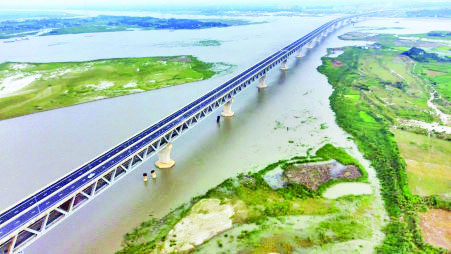Half of river Padma abolished in 40-yr
Impact of Farakka dam
Mahfuja Mukul: The Padma has turned into a desert in the Bangladesh part due to the impact of the Farakka Dam, which caused the increase in the navigability of Kolkata port. The river has lost its navigability, its volume has decreased by about 50 percent. River researchers say, if the fair share of the Ganges agreement is not realized, the existence of Padma, half a hundred native species of fish will be disappeared.
Farakka Dam was built on the Ganga River, 18 km upstream from the western border of Chapainawabganj. The main construction of the dam started in 1961 and was completed in December 1974. As Bangladesh is in the downstream region, any kind of upstream water control will have a negative impact in this country. As a result, Padma lost its buoyancy and took on a gray appearance.
Locals say that the roar of the raging Padma was terrible in the seventies. Padma could not be seen from one end to the other. A large number of different species of fish were available. All this is past now. Dead Padma is a desertedisland.
According to the information of the international scientific journal published by Springer, the volume of the Padma river has decreased by about 50 percent during the dry season compared to 1984. The water depth has decreased by 17.8 percent. Inflows decreased by 26.2 percent. And fresh water supply has reduced by up to 90 percent. The average annual rainfall in the Padma basin has decreased by 19.2 percent.
Associate Professor of Department of Fisheries of Rajshahi University Shams Muhammad Ghalib said, “More than half of the 129 species of fish in nine points of the 70 km section of Padma from Rajshahi’sGodagari to Charghat’s Sarada are in crisis.” At one time many Shushuk or black dolphins were seen in Padma, but now they are on the way to extinction. Aquatic plants under threat in Dead Padma.
Rajshahi University Geography and Ecology Department Professor Dr. Shithanshu Kumar Pal said, ‘The way the water of Padma is decreasing, the biodiversity of this region is under serious threat. If you harm nature, nature will take its revenge. That is what is happening now.
Till 1974, the water flow in Padma was 3 lakh 18 thousand 648 cusecs per second. After the opening of the dam, the flow has dropped to 1 lakh 81 thousand 550 cusecs. According to the 1996 India-Bangladesh 30-year Ganga Water Agreement, if Farakka Point has 70,000 cusecs of water, both countries will get 35,000 cusecs of water. If there is 70 to 75 thousand cusecs of water, Bangladesh will get 35 thousand cusecs and India will get the remaining 35 thousand cusecs. And if there are more than 75 thousand cusecs of water, India will get 40 thousand cusecs and Bangladesh will get the remaining 40 thousand cusecs. Even with the agreement, the real picture is different, say analysts. River researchers are worried about the rate at which the water flow is decreasing.
River researcher Mahbub Siddiqui said, Padma will be in crisis of existence if the fair share of Ganga agreement is not realized. The researcher also questioned the role of the Joint River Commission. Policy makers of Bangladesh have to play an important role to save Padma. Padma will turn into a desert if we do not get our fair share from the neighboring states.
There are 700 rivers and more than 100 international rivers in this riverine country on paper, but there is no accurate count of how many actually survive.
Rare Israeli airstrike in Beirut kills Hezbollah commander and more than a dozen others
International Desk: Israel launched a rare airstrike that killed a senior Hezbollah milita…








